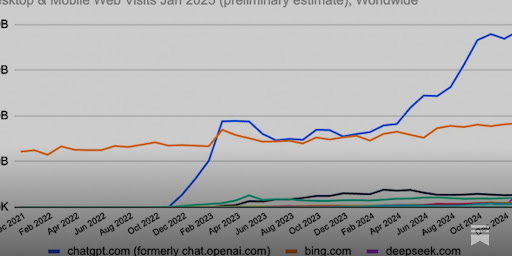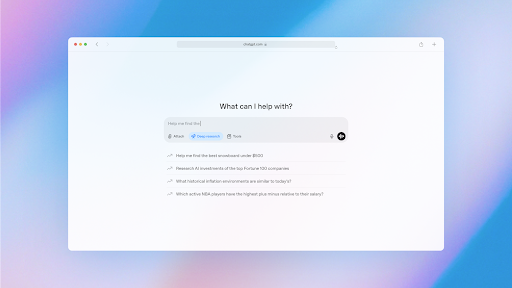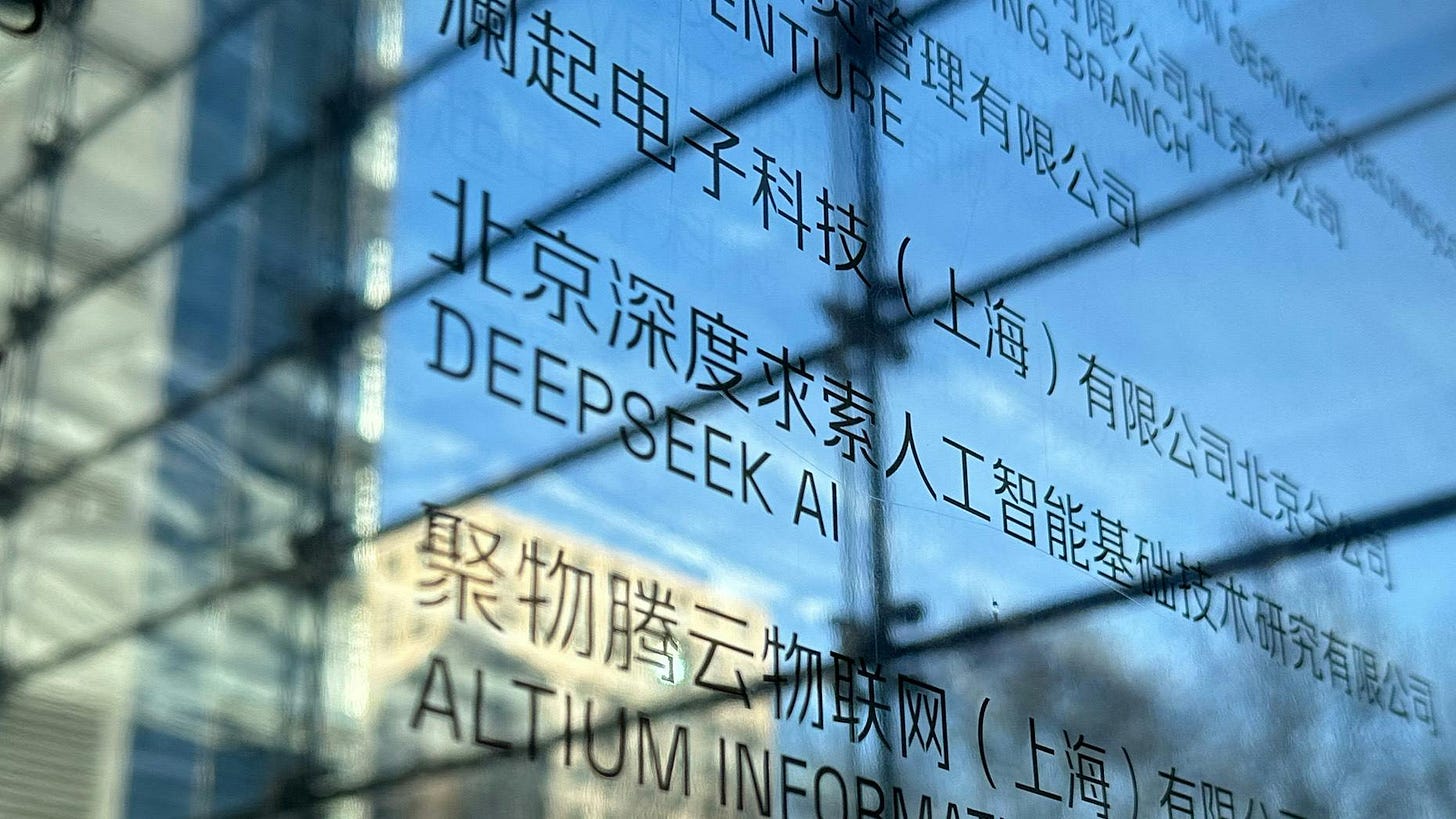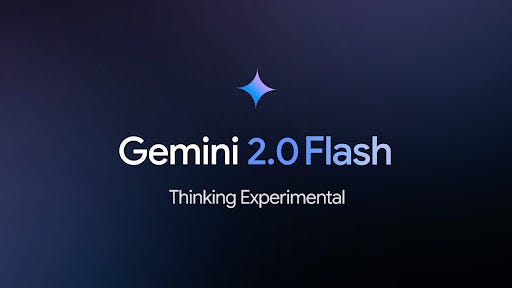Contents
Editorial
Politics & Economics: Two Worlds Collide
Essays of the Week
Post Election
AI
Revenge of the GPT Wrappers: Defensibility in a world of commoditized AI models
DeepSeek Shakes Up AI Landscape But US Still Dominated Venture Funding In January
SoftBank Says It Will Buy $3 Billion Worth of OpenAI Products Annually
Eyeing Higher Margins, AWS and Other Cloud Providers Embrace DeepSeek
Meta Shakes up its Generative AI, Messenger and Facebook Units
Google removes pledge to not use AI for weapons from website
Hugging Face researchers aim to build an ‘open’ version of OpenAI’s deep research tool
Google Launches New Versions of Gemini, Including 'Thinking' Model
OpenAI co-founder John Schulman leaves Anthropic after just five months
Eye On AI: After DeepSeek Hysteria, The AI World Is The Same As It Ever Was
Regulation
Interview of the Week
Ethan Zuckerman and Andrew Keen on US Censorship
Startup of the Week
Post of the Week
Cutting the US Federal Budget - Paul Graham and Elon Musk
Editorial
Politics & Economics: Two Worlds Collide
Most of us experience the world through individual events. For example, the stock market declines, and we react, or a war breaks out, and we react, or AI happens, and we react.
This week, it feels to me as if the entire world is in react mode. The post-US election fallout dominated many of this week’s reactions, but AI also played a role. Reactive thinking is generally poor thinking. Sometimes it is motivated by emotion, sometimes by ideology, and sometimes by instinct. It rarely stands the test of time.
Whether we focus on the DOGE efforts to execute on its mission to make government more efficient, or Trump’s declaration that he wants the US to own Gaza, or OpenAI’s launch of o3-mini-high, almost nobody is standing back, taking a breath, and thinking.
Politics is where reaction lives. In other words, we react in that part of our brains where opinions and emotion live. Politics is not science and is not logical. It is always opinion-based. It can be formed due to deeper thinking, but it rarely is.
So how can we pause and think more deeply? How can we put short-term events into a context that enables us to form views that are born from frameworks we spent time evolving?
Elon Musk’s DOGE events are a huge test case. Many of my friends (maybe you) are appalled by DOGE, especially the media focus on USAID.
The accusation that has gathered popularity is that DOGE is an out-of-control group, with zero authority, ransacking good departments, and breaking the Constitution. I think all of this is reactive political thinking.
DOGE clearly is a government department. It has the authority of the White House. Its stated goal of reducing inefficiency in government certainly encompasses discovering and stopping “bad” spending. It carries the authority of the elected President. It really does not matter that Musk is not himself elected. His role is clearly democratic.
So the real issue becomes whether USAID is misusing taxpayer cash, which it clearly is. Is the President acting constitutionally? And so is Musk acting - under his control - constitutionally? I don’t know. But likely, until the law says otherwise or Congress stops them, the answer is - probably.
It is clearly OK to not like it. But also hard to be against government savings and the firing of bureaucrats without arguing for something. In the case of USAID, the only substantive argument against Trump and Musk seems highly reactive and equally shallow. And very emotional.
Why is this week’s title Politics and Economics: Two Worlds Collide?
It is because I think that the world exists as a kind of layer cake. Most of our life is founded on economics. High growth, increased productivity, and open trade lead to wealth. Wealth generally supports stable life. And stable life results in happy citizens with great lifestyles. Bad economics (slow growth or recession) leads to constraints, which leads to anxiety, which leads to conflict.
Expensive government and bad economics are the worst of all combinations. This combination usually leads to conflict. Hence, the two worlds collide part of the title.
Any attempt to reduce the cost of government leads to resistance by those impacted. That includes those who feed from inefficient government, including various NGOs and employees. Many are good people just making a living. Their reaction is similar to taking a teenager’s allowance away. Not likely to result in a healthy dialogue.
We have to analyze and not simply react. Is government inefficient, and can it be improved? It is pretty hard to say no to that.
The second question is whether those impacted should hold sway over the general imperative. I think the answer has to be no. Of course, humanism matters, and being kind through change is a bonus. But not at the expense of stopping the change.
Economics → Politics → Civil Society → Stability seems a clear way of thinking about the cascading impact of everything.
As such, innovation leading to better economics is the basis for all progress. Resources have to exist before they can be enjoyed.
I also think that cost-saving that doesn’t have a correlated agenda for investment, growth, and modernization is unlikely to create a healthy society. The proposed sovereign wealth fund and ownership in high-growth assets would be a decent start there.
At the bottom, then, I am in favor of DOGE. That said, if I had a voice, I would want it to go after some of the larger budget items (it probably will), and I would want it to have a modernizing agenda alongside its cost-saving agenda. Despite its limitations, DOGE is overall a good.
I have emotional reactions also. I think we should try really hard to rise above them.
AI has had another decade in a week. Please go and try OpenAI’s o3-mini-high model and be amazed by its reasoning abilities.
Essays of the Week
Andreessen Horowitz Defends Hiring Daniel Penny
Author: Mike Isaac and Hurubie Meko Source: NYT > Technology
Published: 2025-02-06 Reading Time: 1 min Domain: nytimes.com
Mr. Penny, who was acquitted after choking a mentally ill subway passenger who died, was hired to join the firm’s American Dynamism investment team.
Partners at Andreessen Horowitz, the blue-chip venture capital firm in Silicon Valley, defended to investors their decision to hire Daniel Penny, a Marine veteran acquitted on a charge of criminally negligent homicide last year, according to an internal memo viewed by The New York Times.
Andreessen Horowitz, the memo said, is most likely the largest investor of public safety and defense venture capital in the country, and “as result, we spend a lot of time with active-duty military, veterans, chiefs of police, sheriffs; these relationships are critical to the success of our companies.”
Mr. Penny’s “military veteran experience can be helpful in continuing to build these relationships, and many of our public safety and defense founders and partners have shared a similar sentiment,” said the memo, which was sent on Wednesday by Jen Kha, the firm’s head of investor relations.
The firm told employees on Tuesday morning that it had hired Mr. Penny. David Ulevitch, an investment partner, said in a separate memo that he had been introduced to Mr. Penny last year and that the veteran had acted with “courage in a tough situation.”
Mr. Ulevitch asked Mr. Penny to join the firm’s American Dynamism investment team, which focuses on the aerospace, defense and manufacturing sectors.
Mr. Ulevitch added that he had conducted “investigations and interviews” with Mr. Penny and believed that Mr. Penny had behaved “honorably and appropriately given the chaotic and dangerous circumstances” on the subway, the memo said.
Soon after the hiring became public, partners at the firm began receiving messages from outsiders and limited partners expressing concern, said two people familiar with the messages, who spoke on the condition of anonymity.
Some of the people asked why Mr. Penny was being hired with no investment experience, while others expressed concern that his highly politicized trial would draw undue attention to the firm…
Google Ends Diversity Hiring Targets
Author: Erin Woo Source: The Information Published: 2025-02-05
Reading Time: 1 min Domain: theinformation.com
Google will no longer set hiring targets for employees from historically underrepresented groups, the company told employees on Wednesday, according to The Wall Street Journal. Google’s parent company, Alphabet, also removed a line from its annual report stating that the company was “committed to making diversity, equity, and inclusion part of everything we do and to growing a workforce that is representative of the users we serve.”
The changes are Google’s second move in two days that seems designed to appeal to the Trump Administration, which has issued executive orders taking aim at DEI requirements. On Tuesday, Google modified its AI Principles to remove promises not to use AI for weapons or surveillance. In a blog post explaining the AI change, company leadership wrote that the company wanted to work with democratic governments to support national security.
The diversity pullback follows similar moves by other tech companies, most notably Meta, reversing diversity policies amidst the Trump Administration’s executive orders taking aim at DEI requirements. A Google spokesperson said that as a federal contractor, it was “evaluating changes required following recent court decisions and executive orders on this topic.”
DOGE Cancels Politico’s Government Funding After $8 Million in Subscription Contracts Revealed
Author: Sean Burch Source: TheWrap Published: 2025-02-05
Reading Time: 1 min Domain: thewrap.com
White House Press Secretary Karoline Leavitt announced Wednesday that Politico will not receive another dime of taxpayer money after it was revealed that the politics-focused news outlet has taken in more than $8 million via subscriptions and other government contracts.
Leavitt said the Department of Government Efficiency, run by Elon Musk, will handle ending Politico’s payments.
Her comment came after X user Adam Townsend posted that Politico had received $8.1 million in taxpayer support. This included several contracts worth hundreds of thousands of dollars for website subscriptions, according to USASpending.gov.
Musk’s Twitter Lenders Sell $5.5 billion Worth of Debt
Author: Martin Peers Source: The Information Published: 2025-02-05
Reading Time: 1 min Domain: theinformation.com
Lenders to Elon Musk’s X, formerly known as Twitter, sold a total of $5.5 billion of debt on Wednesday, the Wall Street Journal reported, more than two years after Musk borrowed $13 billion to help fund his $44 billion buyout of Twitter in 2022.
The debt was sold at 97 cents on the dollar, according to the Journal report, a better price than the lenders originally expected. Typically lenders sell debt soon after a transaction is done but in the case of Twitter, the collapse of its ad business after the takeover forced lenders to hold off.
That delay appears to have paid off. Musk’s high profile as a close advisor to President Trump appears to have made X’s debt more appealing. The debt sale also has brought to the surface details of X’s financial performance. The Journal report said that X earned earnings before interest, taxes, depreciation and amortization of about $1.25 billion in 2024 on revenue of $2.7 billion, which is a margin of 46%. The interest on the debt is around $1.3 billion, however, so X is either losing money or break-even at best.
In 2021, the year before Musk took over, Twitter’s Ebitda was $1.47 billion, excluding a legal settlement, on revenue of $5 billion, or a margin of 29%.
The End of Programming as We Know It
Author: Tim O’Reilly Source: Radar Published: 2025-02-05
Reading Time: 21 min Domain: oreilly.com
There’s a lot of chatter in the media that software developers will soon lose their jobs to AI. I don’t buy it.
It is not the end of programming. It is the end of programming as we know it today. That is not new. The first programmers connected physical circuits to perform each calculation. They were succeeded by programmers writing machine instructions as binary code to be input one bit at a time by flipping switches on the front of a computer. Assembly language programming then put an end to that. It lets a programmer use a human-like language to tell the computer to move data to locations in memory and perform calculations on it. Then, development of even higher-level compiled languages like Fortran, COBOL, and their successors C, C++, and Java meant that most programmers no longer wrote assembly code. Instead, they could express their wishes to the computer using higher level abstractions.

Eventually, interpreted languages, which are much easier to debug, became the norm.
BASIC, one of the first of these to hit the big time, was at first seen as a toy, but soon proved to be the wave of the future. Programming became accessible to kids and garage entrepreneurs, not just the back office priesthood at large companies and government agencies.
Consumer operating systems were also a big part of the story. In the early days of the personal computer, every computer manufacturer needed software engineers who could write low-level drivers that performed the work of reading and writing to memory boards, hard disks, and peripherals such as modems and printers. Windows put an end to that. It didn’t just succeed because it provided a graphical user interface that made it far easier for untrained individuals to use computers. It also provided what Marc Andreessen, whose company Netscape was about to be steamrollered by Microsoft, dismissively (and wrongly) called “just a bag of drivers.” That bag of drivers, fronted by the Win32 APIs, meant that programmers no longer needed to write low-level code to control the machine. That job was effectively encapsulated in the operating system. Windows and macOS, and for mobile, iOS and Android, mean that today, most programmers no longer need to know much of what earlier generations of programmers knew.
There were more programmers, not fewer
This was far from the end of programming, though. There were more programmers than ever. Users in the hundreds of millions consumed the fruits of their creativity. In a classic demonstration of elasticity of demand, as software was easier to create, its price fell, allowing developers to create solutions that more people were willing to pay for.
The web was another “end of programming.” Suddenly, the user interface was made up of human-readable documents, shown in a browser with links that could in turn call programs on remote servers. Anyone could build a simple “application” with minimal programming skill. “No code” became a buzzword. Soon enough, everyone needed a website. Tools like WordPress made it possible for non-programmers to create those websites without coding. Yet as the technology grew in capability, successful websites became more and more complex. There was an increasing separation between “frontend” and “backend” programming. New interpreted programming languages like Python and JavaScript became dominant. Mobile devices added a new, ubiquitous front end, requiring new skills. And once again, the complexity was hidden behind frameworks, function libraries, and APIs that insulated programmers from having to know as much about the low level functionality that it was essential for them to learn only a few years before.
Big data, web services, and cloud computing established a kind of “internet operating system.” Services like Apple Pay, Google Pay, and Stripe made it possible to do formerly difficult, high-stakes enterprise tasks like taking payments with minimal programming expertise. All kinds of deep and powerful functionality was made available via simple APIs. Yet this explosion of internet sites and the network protocols and APIs connecting them ended up creating the need for more programmers.
Programmers were no longer building static software artifacts updated every couple of years but continuously developing, integrating, and maintaining long-lived services. Even more importantly, much of the work at these vast services, like Google Search, Google Maps, Gmail, Amazon, Facebook, and Twitter, was automated at vast scale. Programs were designed and built by humans, not AI, but much of the work itself was done by special-purpose predecessors to today’s general purpose AIs. The workers that do the bulk of the heavy lifting at these companies are already programs. The human programmers are their managers. There are now hundreds of thousands of programmers doing this kind of supervisory work. They are already living in a world where the job is creating and managing digital co-workers…
AI Weeks When Decades Happen
Author: Tomas Pueyo Source: Uncharted Territories Published: 2025-02-06
Reading Time: 4 min Domain: unchartedterritories.tomaspueyo.com
Last week, I shared how much closer we are getting to the singularity—when AI will be better than us at every human task, at which point nothing else is predictable.
Since, OpenAI has fully released its new model, o3, with the Deep Research mode. Today, we’re going to look at this release and how it will affect your jobs in the coming months and years.
o3
An organization devised Humanity’s Last Exam two weeks ago:
The goal was to make the last exam we would ever need to gauge the intelligence of AIs: If they passed it, we could declare AIs are more intelligent than us.
Ten days later:
Let me graph this for you:
From Tyler Cowen:
“Adam Brown, who does physics at a world class level, put it well in his recent podcast with Dwarkesh. Adam said that if he had a question about something, the best answer he would get is from calling up one of a handful of world experts on the topic. The second best answer he would get is from asking the best AI models.”
So now only a handful of physicists are better than AIs in physics.
Arguably, Masayoshi Son, the CEO of SoftBank, one of the biggest investors in the world, had early access to o3. That’s why it decided to co-invest in the $500B AI investment announced last week. This is what he had to say:
Just a year ago, I thought AGI would arrive in 10 years. A few months after that, I said it would arrive in 2–3 years. But now, I want to correct it by saying it will arrive sooner than that.
That’s the context to understand this from Sam Altman:
How Will All This Affect Your Jobs?
In these three articles, I explained how we can expect AI to affect jobs…
Read more
DeepSeek: AI's Sputnik Moment? Tech Veterans Weigh In
Author: Martin Casado and Steven Sinofsky Source: a16z Published: 2025-02-07 Reading Time: 1 min
Domain: youtube.com
The Chinese reasoning model r1 is rivaling others at the frontier with an open-source MIT license, methods that some claim may be 45x more efficient, an alleged $5.6m cost, the release of reasoning traces, a follow-on image model, and the fact that all of this was released by a hedge fund China. Many are already referring to this as a Sputnik moment. If that’s true, how should we – whether founder, researcher, policy maker – not just react, but act? Joining us to tease out the signal from the noise are a16z General Partner Martin Casado and a16z board partner, Steven Sinofsky. Both Martin and Steven have been on the frontlines of prior computing cycles, from the switching wars to the fiber buildout, and have witnessed the trajectories of companies like Cisco to AOL to ATT – even Worldcom. So what really drove this DeepSeek frenzy and more importantly what should we take away? Today, we answer that question through the lens of Internet history.
Revenge of the GPT Wrappers: Defensibility in a world of commoditized AI models
Why network effects and distribution will be king, once more
Author: Andrew Chen Published: 2025-02-06 Reading Time: 13 min
Domain: andrewchen.substack.com
Growth and network effects soon to return as a dominant force
The AI landscape has evolved a ton in the past year, with many new entrants, booming traction for many AI-first products, and existential questions for foundation model startups. These questions include:
What if there’s low defensibility for AI model startups, and there continue to be open source alternatives and new entrants that erode advantage over time? Who ends up winning instead?
New AI-first apps benefit from novelty effect and are seeing stunning growth. But imagine, with time, that this goes away as AI becomes an expectation, not a novelty. In a world of millions of new products, who wins the distribution game? How will products grow and reach their customers in a crowded market?
Imagine it becomes truly trivial to copy cat another product — something as simple as, “hey AI, build me an app that does what productxyz.com does, and host it at productabc.com!” In the past, a new product might have taken a few months to copy, and enjoyed a bit of time to build its lead. But soon, perhaps it will be fast-followed nearly instantly. How will products hold onto their users?
In recent years, innovative AI products that didn’t build their own models were derided as low-tech “GPT wrappers.” Yet consumer products for the past few decades have been low-tech, with seemingly small moats and yet have generated huge value. Will the future follow the past?
I’ll argue that it’s in this environment of a massive war between “GPT wrappers” that the traditional defensibility strategies — particularly sustained advantages in distribution and network effects — will return to the forefront. They won’t manifest in exactly the same ways, but instead, hybridize with AI features to create something new. In that way, the next gen of AI products will ride some of the forces that have driven the last few waves of computing, whether in Web 2.0 or crypto or the on-demand economy…
Boom Times For ChatGPT
Author: Alex Kantrowitz Source: Big Technology Published: 2025-02-07
Reading Time: 5 min Domain: bigtechnology.com
ChatGPT is booming. After months of stagnant usage in early 2024, the chatbot hit an inflection point and is now far outpacing its competition, according to new data from analytics firm Similarweb.
OpenAI’s flagship bot hit 3.8 billion visits on desktop and mobile web in January 2025, more than doubling Bing, its nearest competitor, and leaving Google’s Gemini, Anthropic’s Claude, and Perplexity far behind. The traffic surge is a remarkable reversal for ChatGPT following a usage stagnation that lasted longer than a year. After reaching 1.9 billion visits in March 2023, ChatGPT didn’t surpass that number until May 2024.
“The first rush was about novelty, people trying it out. They do seem to have transitioned to where more people have found practical uses for the app,” David Carr, editor for insights news and research at SimilarWeb, told me.
ChatGPT's deep research might be the first good agent
Author: Casey Newton Source: Platformer Published: 2025-02-04
Reading Time: 16 min Domain: platformer.news
This is a column about AI. My boyfriend works at Anthropic. See my full ethics disclosure here.
It feels odd to be writing a newsletter about new technology on a day like this. Elon Musk and his team of henchmen are working to dismantle the federal government with stunning speed. As many observers have noted, Musk’s initiative closely resembles his ruinous takeover of Twitter. And he’s now having his team remove X posts that name the people in charge of this new effort, a move that in his capacity as a federal government employee may actually violate the First Amendment. Former White House lawyers are calling the whole thing “wrong and illegal.” Just describing what is happening in plain language can make you wonder if you sound like a crank. But you are not a crank. The United States’ system of checks and balances — and the rule of law itself — are under direct assault; the Republicans who control Congress appear content to let it happen; and the risks that we fall into authoritarian collapse look as grave as they ever have.
But I’m going to assume that you knew all that already, and are perhaps looking today for a little distraction. In which case: let’s talk about OpenAI’s deep research.
DeepSeek Shakes Up AI Landscape But US Still Dominated Venture Funding In January
Author: Gené Teare Source: Crunchbase News Published: 2025-02-05
Reading Time: 4 min Domain: news.crunchbase.com
Global venture funding totaled $26 billion in January, with healthcare and AI again emerging as the top sectors for startup investment, Crunchbase data shows.
And while the launch of China-based DeepSeek’s open source model R1 rattled the public markets in late January, last month’s venture funding numbers show the U.S.’ AI startups have continued to raise significant sums — at least for now.
AI startups including Anthropic, ElevenLabs and Hippocratic AI raised billions of dollars last month, and the U.S. startup market overall continued to dominate, receiving more than 60% of total global venture funding in January.
SoftBank Says It Will Buy $3 Billion Worth of OpenAI Products Annually
Author: Stephanie Palazzolo Source: The Information Published: 2025-02-04
Reading Time: 1 min Domain: theinformation.com
SoftBank said on Monday it would spend $3 billion per year on technology from OpenAI for itself and its subsidiaries, such as chip designer Arm and electronic payment service PayPay. The commercial relationship will boost OpenAI’s revenue as well as its relationship with SoftBank, which is an existing investor in OpenAI and has been in talks to lead a $40 billion financing of OpenAI that could value it at around $300 billion, including the new capital.
The Japanese telecom conglomerate and OpenAI said they will also establish a joint venture to market a suite of OpenAI tools, branded as Cristal Intelligence, exclusively to companies in Japan. Cristal Intelligence will include a version of ChatGPT for businesses as well as OpenAI’s application programming interface. It also “securely integrate[s]” with the “systems and data of individual enterprises in a way that is customized specifically for each company.” Large consulting firms often handle such customization for AI customers, so the joint venture could become a competitor.
Earlier this month, SoftBank also partnered with OpenAI and Oracle as part of a venture, called “Stargate,” to raise $100 billion initially, and $400 billion more over several years to spend on data centers to power OpenAI’s technology.
Eyeing Higher Margins, AWS and Other Cloud Providers Embrace DeepSeek
Author: Jon Victor Source: The Information Published: 2025-02-04
Reading Time: 1 min Domain: theinformation.com
The DeepSeek reasoning artificial intelligence, R1, isn’t just a gift to businesses eager to cut their AI costs. American cloud providers looking to boost their server rental businesses moved quickly last week to make R1 available to their customers.
So far, however, Amazon Web Services, Microsoft and Google aren’t charging cloud customers to use DeepSeek, which is open source, the same way they charge for other models—based on how much text the models generate. Instead, businesses using DeepSeek only pay for the computing resources they use.
By contrast, customers buying Meta’s Llama on AWS or Microsoft's Azure cloud can pay a fixed amount depending on how much text the model processes or generates.
The cloud providers’ arrangement for DeepSeek suggests they raced to provide access to the buzzy model while they continue to work through whether to charge a set price, as smaller AI cloud server providers already have done. Spokespeople for AWS and Google said charging for open-source models based on server usage is more common than charging based on how much information the model produces, known as an output.
While DeepSeek is cheaper for many companies to use than many American-made AI models because it processes information more efficiently, it’s potentially more lucrative for the cloud providers. That’s because renting cloud servers to run models typically costs more than paying to access a model through an application programming interface, said Jesse Han, founder and CEO of AI cloud infrastructure startup Morph Labs.
AWS, for example, charges as much as $124 per hour to rent a server that’s tailored to running AI. Running such a server continuously would cost around $90,000 per month. A Microsoft spokesperson said customers don’t need to rent entire servers to use DeepSeek on Azure, but they still have to pay for the computing power to run it. That can lead to variability in cost as some customers run the model more efficiently.
In comparison, using the highest-quality version of Meta’s Llama 3.1 model through AWS costs $3 per 1 million tokens, a much lower commitment for companies that aren’t using the AI as much, or only do so sporadically. A token is typically a word or grouping of words, and a 750-word document is around 1,000 tokens, according to AI infrastructure startup Anyscale.
Small cloud firms like Together AI and Fireworks AI are already offering DeepSeek’s R1 with fixed per-token pricing rather than basing the price on server usage.
Meta Shakes up its Generative AI, Messenger and Facebook Units
Author: Kalley Huang Source: The Information Published: 2025-02-04
Reading Time: 1 min Domain: theinformation.com
Meta Platforms is merging the teams behind Facebook and Messenger into one unit as the company prepares for layoffs across the business next week. Under the change, the head of Messenger, Loredana Crisan, will move to the company’s generative artificial intelligence group, while Facebook’s chief Tom Alison will also oversee Messenger, according to two people with direct knowledge of the situation.
Meta is also shuffling its generative AI group, which is responsible for the company’s key bets in AI, including its flagship AI model Llama and its Meta AI assistant. Ryan Cairns and Ning Li, engineering leaders in the group, will both move to other parts of Meta, according to one of the people. Both joined the generative AI group in November 2023, according to their profiles on LinkedIn.
The reorganizations are among several recent internal shakeups as Meta gears up for another round of mass layoffs, which are due to be announced Monday. Last week, Meta broke up the business unit inside Reality Labs, the department that develops augmented and virtual reality technology, and moved most of the work under Meta’s Chief Operating Officer Javier Olivan….
Google removes pledge to not use AI for weapons from website
Author: Maxwell Zeff Source: TechCrunch Published: 2025-02-04
Reading Time: 2 min Domain: techcrunch.com
Google removed a pledge to not build AI for weapons or surveillance from its website this week. The change was first spotted by Bloomberg. The company appears to have updated its public AI principles page, erasing a section titled “applications we will not pursue,” which was still included as recently as last week.
Google’s newly updated AI principles note the company will work to “mitigate unintended or harmful outcomes and avoid unfair bias,” as well as align the company with “widely accepted principles of international law and human rights.”
Figure drops OpenAI in favor of in-house models
Author: Brian Heater Source: TechCrunch
Published: 2025-02-04 Reading Time: 5 min Domain: techcrunch.com
OpenAI has been a longtime investor in Figure. The two companies announced a deal last year that aimed to “develop next generation AI models for humanoid robots.” At the same time, Figure announced a $675 million raise, valuing the company at $2.6 billion. Figure has so far raised a total of $1.5 billion from investors.
The news is a surprise, given the role that OpenAI plays in the cultural zeitgeist. Mere association with the company comes with a rapid profile boost. In August, the two companies announced that the Figure 02 humanoid would use OpenAI models for natural language communication.
The issue with the collaboration, according to Adcock, is integration. OpenAI is a huge company with a massive breadth — and the intelligence models to match. Embodied AI, which brings artificial intelligence to physical objects such as robots, isn’t the ChatGPT maker’s primary focus. Instead, Adcock suggests, the proper solution is building an end-to-end AI model focused on powering specific hardware.
That is not the priority for Figure, however. After all, automakers have deeper pockets than individuals when it comes to exploring new technology. BMW announced last year that it had begun deploying Figure robots at a South Carolina factory.
OpenAI may also be exploring its own humanoid hardware. On Friday, the company filed a trademark application with the U.S. Patent and Trademark Office (USPTO) involving humanoids. The text references both “user-programmable humanoid robots” and “humanoid robots having communication and learning functions for assisting and entertaining people.”
Hugging Face researchers aim to build an ‘open’ version of OpenAI’s deep research tool
Author: Kyle Wiggers Source: TechCrunch Published: 2025-02-04
Reading Time: 4 min Domain: techcrunch.com
A group of developers at AI dev platform Hugging Face, including Thomas Wolf, the company’s co-founder and chief scientist, say they’ve built an “open” version of OpenAI’s deep research tool.
Deep research, which OpenAI unveiled during an event Sunday, crawls the web to compile research reports on any subject. While impressive, deep research is currently only available in limited preview to users subscribed to OpenAI’s $200-a-month ChatGPT Pro plan.
The Hugging Face team’s project, which they’re calling Open Deep Research, consists of an AI model — OpenAI’s o1 — and an open source “agentic framework” that helps the model plan its analysis and guides it to use tools like search engines. O1 is a proprietary model (i.e. gated behind a paid API), but the team says it delivered better performance than “open” models such as DeepSeek’s R1.
In less than 24 hours, the researchers were able to harness o1 to use a simple, text-based browser and a “text inspector” toolkit to read files across the web. Open Deep Research can navigate the web autonomously, the team says, scrolling through pages, manipulating files, and even running calculations with data.
On GAIA, a benchmark for general AI assistants, Open Deep Research achieves a score of 54%. That’s compared with OpenAI deep research’s score of 67.36%.
Google Launches New Versions of Gemini, Including 'Thinking' Model
Author: Juli Clover Source: MacRumors Published: 2025-02-05
Reading Time: 1 min Domain: macrumors.com
Google today announced updates to Gemini, the company's AI product that competes with OpenAI's ChatGPT, DeepSeek, and Apple Intelligence.
Starting today, Gemini app users can access Google's 2.0 Flash Thinking Experimental model, which is trained to break down prompts into a series of steps to improve its reasoning capabilities. The new model shows its reasoning process, giving users insight into why it responds the way that it does.
There is a version of 2.0 Flash Thinking that is able to interact with apps that include YouTube, Search, and Google Maps, with Google working to determine how the new reasoning capabilities can help users do more with Google apps.
An experimental version of Gemini 2.0 Pro is also now available, and Google says it is the best model yet for coding performance and answering complex prompts. Gemini 2.0 Pro is available in Google AI Studio, Vertex AI, and the Gemini app for Gemini Advanced subscribers.
A Gemini 2.0 Flash-Lite model is available for Google AI Studio as well, and Google says that it is the most cost-efficient model to date.
Gemini 2.0 Flash Thinking Experimental and 2.0 Pro Experimental are rolling out to the Gemini web and mobile app. They can be selected in the Gemini dropdown menu when interacting with the AI.
Read more
OpenAI co-founder John Schulman leaves Anthropic after just five months
Author: Kyle Wiggers Source: TechCrunch Published: 2025-02-06
Reading Time: 2 min Domain: techcrunch.com
OpenAI co-founder and prominent AI researcher John Schulman has left Anthropic after five months, according to multiple reports.
Credited as one of the leading architects of ChatGPT, Schulman left OpenAI last August for its direct competitor, Anthropic. He posted about the decision on X, saying it stemmed from a desire to deepen his focus on AI alignment — the science of ensuring AI behaves as intended — and engage in more hands-on technical work.
“[At Anthropic], I believe I can gain new perspectives and do research alongside people deeply engaged with the topics I’m most interested in,” Schulman wrote.
Schulman hasn’t publicly addressed his departure from Anthropic, nor has he indicated what he plans to do next. In a statement provided to Bloomberg, Anthropic’s chief science officer, Jared Kaplan, said that he was “sad to see John go,” but “fully support[s] his decision to pursue new opportunities.”
Eye On AI: After DeepSeek Hysteria, The AI World Is The Same As It Ever Was
Author: Chris Metinko Source: Crunchbase News Published: 2025-02-06
Reading Time: 3 min Domain: news.crunchbase.com
It’s been nearly two weeks since Chinese AI app DeepSeek rocked the artificial intelligence world, shaking up not just the public market but also the confidence of a lot of VCs who’ve built up massive AI portfolios.
But despite the panic last week, it‘s now starting to seem like nothing materially changed in the industry as money continues to pour in for AI — with the promise of even more.
By late last week, there was a report that SoftBank is looking to invest between $15 billion and $25 billion into OpenAI — just days after DeepSeek claimed to have created AI models that rival even those of the ChatGPT creator, but at much lower cost and using less energy.
OpenAI’s new round would value the AI giant at $300 billion — nearly doubling the $157 billion the company was valued at in October when it raised a $6.6 billion round led by Thrive Capital at a post-money valuation of $157 billion.
Not just OpenAI
SoftBank isn’t the only one still happy to pour billions into AI. Private equity giant Blackstone Group — which has invested tens of billions of dollars into data centers needed for AI compute — said last week in a post-earnings call that while it will watch developments with DeepSeek, it has no plans to pull back from the “very important segment.”
Just last year it was reported Blackstone — the world’s largest asset manager — plans to invest $8.2 billion to develop data centers in Spain. In 2023, it partnered with Digital Realty to develop $7 billion in data centers targeting providers of online content, cloud services and artificial intelligence. Blackstone also is a backer of AI infrastructure startup CoreWeave and just made a $300 million investment into data storage company DDN, valuing it at $5 billion.
Of course the DeepSeek news is far too recent for us to see if venture investors are pulling back from the space, but January’s numbers seem to indicate they have little desire to invest less money into AI — likely even if a foreign AI competitor gains some traction.
Last month, investors poured nearly $5.7 billion into AI-related startups, per Crunchbase data.
While it is true that is a steep decline from the past few months — November and December both saw more than $15 billion invested in such startups — January also lacked any massive rounds such as the ones raised by OpenAI and xAI late last year…
Google's Future in Search & AI by @ttunguz
Published: 2025-02-07 Reading Time: 2 min Domain: tomtunguz.com
Google’s earnings call identified some major changes and unexpected outcomes, including the performance of AI Ads, the importance of hardware compared to algorithmic efficiency gains, and the groundswell of developer adoption for Gemini models.
AI algorithms have had a thousand times reduction in inference cost over the last three years. There is another cost reduction curve, which is the compute per watt of electricity. Google reveals that this is decreasing at half of the rate of algorithmic efficiency. But it can be just as meaningful.
“Google data centers deliver nearly 4x more computing power per unit of electricity compared to just 5 years ago. These efficiencies, coupled with the scalability, cost and performance we offer are why organizations increasingly choose Google Cloud’s platform. In fact, today, Cloud customers consume more than 8x the compute capacity for training and inferencing compared to 18 months ago”
U.K. orders Apple to let it spy on users’ encrypted accounts
Published: 2025-02-07 Reading Time: 6 min Domain: washingtonpost.com
Security officials in the United Kingdom have demanded that Apple create a back door allowing them to retrieve all the content any Apple user worldwide has uploaded to the cloud, people familiar with the matter told The Washington Post.
The British government’s undisclosed order, issued last month, requires blanket capability to view fully encrypted material, not merely assistance in cracking a specific account, and has no known precedent in major democracies. Its application would mark a significant defeat for tech companies in their decades-long battle to avoid being wielded as government tools against their users, the people said, speaking under the condition of anonymity to discuss legally and politically sensitive issues.
Rather than break the security promises it made to its users everywhere, Apple is likely to stop offering encrypted storage in the U.K., the people said. Yet that concession would not fulfill the U.K. demand for backdoor access to the service in other countries, including the United States.
Interview of the Week
Startup of the Week
Deel unloads $300M in secondary sale, brings General Catalyst on as an investor
Author: Mary Ann Azevedo Source: TechCrunch Published: 2025-02-04
Reading Time: 2 min Domain: techcrunch.com
Fintech-turned-HR outfit Deel is trying to lay the groundwork for an IPO. On Tuesday, it said its annual revenue run rate climbed to $800 million in 2024 after growing by 70%.
The startup, which helps businesses globally hire, manage and pay employees remotely, also said it has sold $300 million in secondary shares to General Catalyst and an unnamed “sovereign investor” — giving early investors a payout. CNBC reported that the unnamed investor is Mubadala Investment Company, the sovereign wealth fund of Abu Dhabi.
In May 2022, Deel was valued at $12 billion. After its secondary sale, its valuation was $12.6 billion, according to CNBC.
The company recently filed a motion asking a Florida court to dismiss a lawsuit that charged that Deel enabled money laundering.
Post of the Week
A reminder for new readers. Each week, That Was The Week, includes a collection of selected essays on critical issues in tech, startups, and venture capital. I choose the articles based on their interest to me. The selections often include viewpoints I can't entirely agree with. I include them if they provoke me to think. Click on the headline, contents link, or the ‘Read More’ link at the bottom of each piece to go to the original. I express my point of view in the editorial and the weekly video below. There is a weekly News of the Week supplement that has the week’s most interesting news,
Hat Tip to this week’s creators:



































